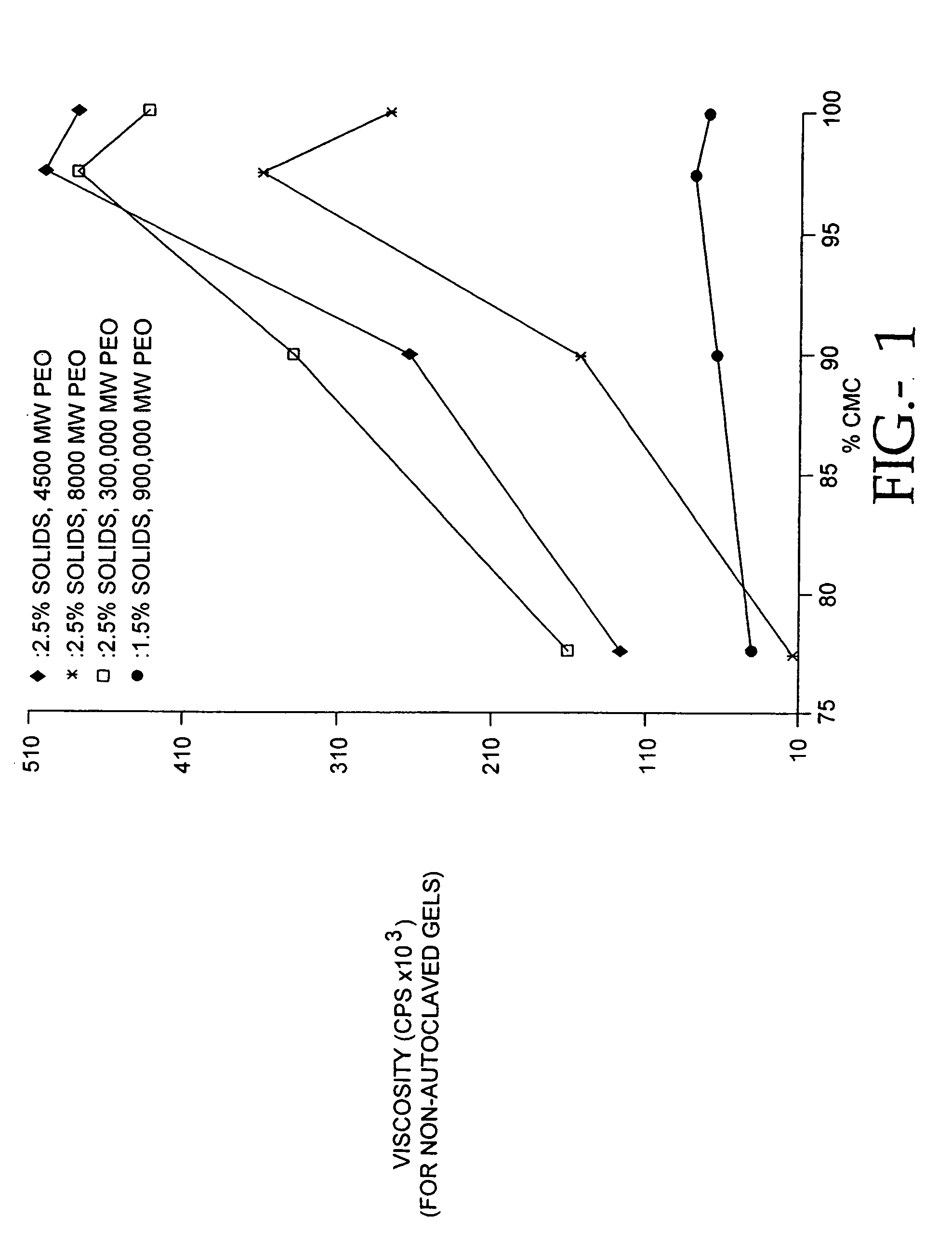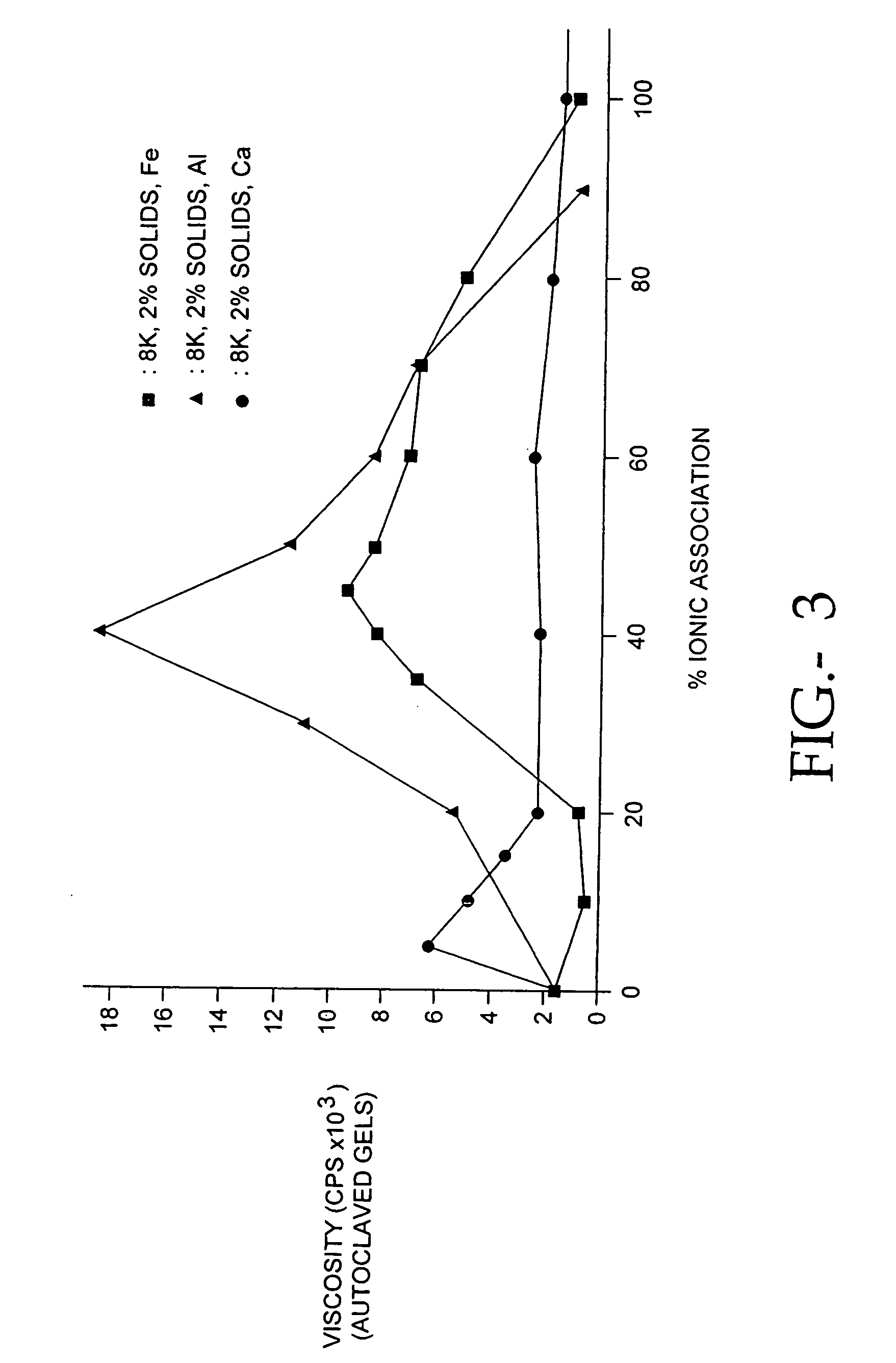Compositions of polyacids and polyethers and methods for their use as dermal fillers
a technology applied in the field of compositions of polyacids and polyethers and methods for their use as dermal fillers, can solve the problems of high manufacturing cost, and achieve the effects of improving biocompatibility, improving biocompatibility, and improving consistency
- Summary
- Abstract
- Description
- Claims
- Application Information
AI Technical Summary
Benefits of technology
Problems solved by technology
Method used
Image
Examples
example 1
Viscosity of Hydrogels
[0094]Because the antiadhesion properties of a hydrogel are dependent upon its viscosity, we determined the relationship between casting solution pH and the viscosity of the hydrogel. We determined the viscosity of PCS / PE solutions at 22° C. using a Brookfield™ viscometer. Using methods published in the brochure Cellulose Gum, Hercules, Inc., Wilmington, Del., (1986), page 28. Briefly, the composition of the solution to be tested is selected, and by referring to Table XI on page 29 of Cellulose Gum, the spindle number and spindle revolution speed is selected. Viscosity measurements are made within 2 hr after stirring the solution. After placing the spindle in contact with the solution, and permitting the spindle to rotate for 3 minutes, the viscosity measurement is read directly in centipoise on a Brookfield Digital Viscometer (Model DV-II). We studied 65% CMC / 35% PEO solutions made with 7HF PH CMC and 1000 kd PEO at a pH of 7.5. Another 65% CMC / 35% PEO solutio...
example 2
Intracutaneous Reactivity of CMC / PEO Films
[0097]Introduction:
[0098]The purpose of this test was to evaluate the potential of the test material to produce irritation following intracutaneous injections into rabbits.
[0099]Methods:
[0100]1. Animals:
[0101]As in the previous examples, New Zealand White rabbits were used for this study. The rabbit is the species required by the current version of the International Organization for Standardization. They were obtained from Grimaud Farms of California, Stockton, Calif. Three adult female animals were used, and weighed between 2.2 and 2.3 kg each. The animals were housed individually and maintained at 16–22° C. and 50±20% relative humidity. They were fed Laboratory Rabbit Diet (approximately 200 grams per day) and water ad libitum and had a light:dark cycle of 12 hours on–12 hours off.
[0102]2. Sample Preparation:
[0103]For the SCI extract, a dry sterile glass tube with a screw cap was filled with 20 ml of the appropriate extracting medium. Two ...
example 3
Effect of the CMC / PEO Compositions on Gross and Histopathology
[0115]Introduction:
[0116]The purpose of this study was to determine the effect of placement of 10 to 20 times the expected clinical dose of CMC / PEO films of this invention on the gross and microscopic appearance of the liver, kidney, bladder, bowel, abdominal wall, heart, lung and ovaries.
[0117]Methods:
[0118]1. Animals:
[0119]Twelve female New Zealand White rabbits, 2.4–2.7 kg, were purchased and quarantined for at least 2 days prior to use. The rabbits were housed on a 12:12 light:dark cycle with food and water available ad libitum.
[0120]2. Materials:
[0121]Gamma-irradiated (2.5MRad) CMC / PEO films (55.2 cm2 (10×expected dose) or 110.7 cm2 (20×the expected dose per rabbit) were implanted surgically into the peritoneal cavities of rabbits. The sutures that were used to close the peritoneum and skin is 3-0 coated Dexon II suture (Davis and Geck, Manati, PR).
[0122]3. Sidewall Model:
[0123]Adhesions were induced using the same m...
PUM
| Property | Measurement | Unit |
|---|---|---|
| molecular weight | aaaaa | aaaaa |
| molecular weight | aaaaa | aaaaa |
| atmospheric pressure | aaaaa | aaaaa |
Abstract
Description
Claims
Application Information
 Login to View More
Login to View More - R&D
- Intellectual Property
- Life Sciences
- Materials
- Tech Scout
- Unparalleled Data Quality
- Higher Quality Content
- 60% Fewer Hallucinations
Browse by: Latest US Patents, China's latest patents, Technical Efficacy Thesaurus, Application Domain, Technology Topic, Popular Technical Reports.
© 2025 PatSnap. All rights reserved.Legal|Privacy policy|Modern Slavery Act Transparency Statement|Sitemap|About US| Contact US: help@patsnap.com



